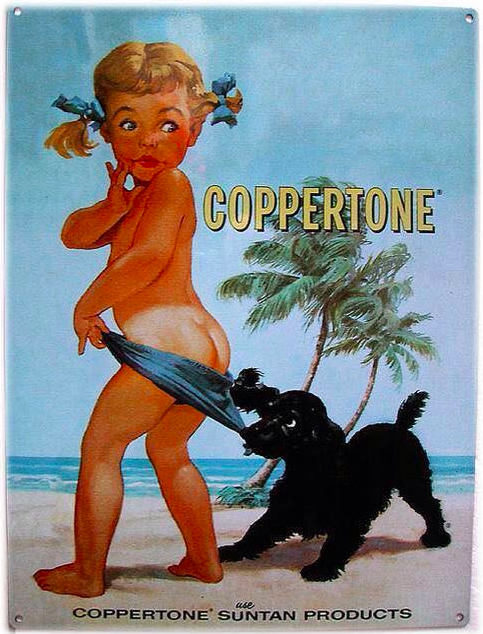
I. SUNSHINE STATES
Not long ago, my mother asked me if I remembered the Coppertone billboard in Surfer’s Paradise. I didn’t. I had spent most of my childhood holidays on Gold Coast beaches with my mother. I had been rescued by lifesavers from the waves all along that stretch of southern Queensland, and learned to bodysurf, and watched my hair bleach blonde in the sun, but I had no memory of the billboard in Surfer’s Paradise.
My mother told me that the Coppertone billboard was erected in Surfer’s Paradise during the 1960s, when she was a child. Growing up on the beaches of the Gold Coast, my mother knew Surfer’s Paradise as the El Dorado for a certain kind of sunshine-seeking Australian schemer. The beachfront was built up during the 1980s when economic deregulation led to a boom in ugly skyscrapers, gold chains and perms, but in the 1960s the Gold Coast was still gorgeous.
When Coppertone erected their billboard in Surfer’s Paradise, the town felt and looked liked a small-scale version of Miami, where the company had erected its original sign on Biscayne Boulevard a decade earlier. The billboard featured Little Miss Coppertone. Since 1953, she has been the international mascot for Coppertone sunscreen. She wears pigtails and navy blue bikini pants, and she is caught in a moment of perpetual surprise. She turns, looking behind her at the little black dog biting her pants and yanking them down. The yanked-down bikini pants reveal the tan line across the little girl’s back and the bright white skin on her bottom. “Don’t be a paleface,” read the type beneath the girl and the dog on the billboard in Surfer’s Paradise.
My mother told me that she had seen the Coppertone billboard again on a recent visit to Queensland. It was in the same place it had always been, on the same stretch of roadside, but there had been a change. “Now,” my mother told me, “the little girl wears a full-piece swimming costume. The dog is still pulling her pants down. But you don’t see the color shift anymore when we bites her. Because you’re not meant to get a tan anymore, and you’re not meant to show little girls’ bottoms.”
In Australia, there is a poem that everybody knows called “My Country.” Children are taught to recite the poem in school, and it has been featured in everything from anti-littering campaigns to advertisements for Tip Top bread. Written by Dorothea McKellar in 1908, most adults have retained only a few lines from the second stanza:
I love a sunburnt country
A land of sweeping plains
Of ragged mountain ranges
Of droughts and flooding rains.
The poem...
You have reached your article limit
Sign up for a digital subscription and continue reading all new issues, plus our entire archives, for just $1.50/month.
Already a subscriber? Sign in




